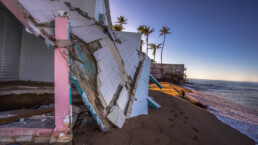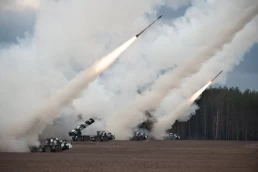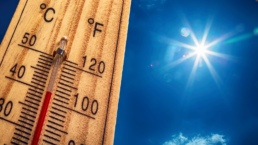Five years after Maria, another slow-moving storm “catches the island at the very worst moment.”
By Naveena Sadasivam, Grist
This story was originally published by Grist. You can subscribe to its weekly newsletter here.
Hurricane Fiona slammed into Puerto Rico Sunday afternoon, causing widespread destruction, leaving 1.4 million residents without power and 700,000 without running water. The National Weather Service has warned that the Category 1 storm will cause “life-threatening and catastrophic flooding.” Indeed, the slow-moving hurricane had dropped more than 30 inches of rain on parts of Puerto Rico as of Monday, when it made landfall in the Dominican Republic. Only 100,000 Puerto Ricans have seen their power restored so far.

According to the Puerto Rican governor, Fiona dumped more rain on some parts of Puerto Rico than Hurricane Maria, which made landfall almost exactly five years ago and caused an estimated 4,645 deaths. As water levels rose in the Guaonica River, a temporary metal bridge, built after Hurricane Maria destroyed the previous one, floated away in the floodwaters. One man died during the power outage while trying to operate a generator, and Governor Pedro Pierluisi reported that the National Guard had rescued more than 1,000 stranded people.
Hurricane Fiona “catches the island at the very worst moment, right after an incomplete recovery from Hurricane Maria when the electric grid is very frail,” said Juan Declet-Barreto, a senior social scientist studying climate vulnerability at the Union of Concerned Scientists, a nonprofit advocacy group. “It’s just a very, very difficult situation.”
Slow-moving hurricanes like Fiona are expected to become more common in a warming world. Climate researchers have found that once storms make landfall, they are now moving more slowly and taking longer to weaken compared to previous years, thereby increasing the amount of rainfall they’re likely to produce. While it’s too early to know the exact role that climate change played in Hurricane Fiona’s intensity, Declet-Barreto said that global warming is creating conditions that allow for the rapid intensification of hurricanes, lots of rain, and heavy winds.
Puerto Rico was supposed to be better prepared for the next major storm after Maria. In the aftermath of the devastating 2017 hurricane, the Federal Emergency Management Agency, or FEMA, allocated $25 billion to help the island’s municipalities rebuild parks, community centers, and other much-needed infrastructure. But an Associated Press review of government data found that just 21 percent of more than 5,500 government-funded recovery projects have been completed five years later. Of the island’s 78 municipalities, seven reported that not a single project had broken ground. More than 3,600 Puerto Rican homes were still covered with blue tarps distributed half a decade ago.
The island has also spent massive amounts of money on fixing its electrical grid, which proved vulnerable during both storms. Until last year, the grid fell entirely under the purview of the Puerto Rico Electric Power Authority, or PREPA, a public utility owned by the Puerto Rican government. Laden with $9 billion in debt, the utility filed for bankruptcy just months before Hurricane Maria made landfall. In the midst of restructuring its debt, the utility struck a deal to contract electricity transmission and distribution to LUMA Energy, a private company. LUMA officially took over operations in June 2021, but Puerto Ricans have seen few improvements in power reliability since then. In fact, blackouts have persisted over the last year, causing Puerto Ricans to take to the streets demanding that LUMA’s 15-year contract be canceled. One particularly terrible outage occurred in April when a fire at the island’s main power plant caused blackouts for half a million people. The power was out for days, leading the education department to cancel classes.
After LUMA took over last year, it did not honor the existing collective bargaining contracts with a local union. As a result, the company lost many experienced workers with decades of institutional knowledge. “LUMA had to start from zero building a workforce and still to this point, does not have sufficient people to work the grid,” said Adi Martínez-Román, the director of operations at the University of Puerto Rico’s Resilience Law Center. LUMA and PREPA have failed to build a climate-resilient grid and have instead been submitting project plans that build back infrastructure to pre-Maria standards, she said.
Martínez-Román pointed out that a 10-year PREPA plan to use FEMA funds for rebuilding the grid includes construction of natural gas plants and extends the island’s reliance on fossil fuels. As an island, Puerto Rico is reliant on ships to ferry fossil fuels to its power plants, which makes it unreliable during hurricanes and vulnerable to oil and gas price fluctuations. Puerto Ricans already pay double the U.S. national average cost for power.
“We are an island that has sun almost all the time,” she said. “That’s a missed once-in-a-lifetime opportunity to use federal funds for a decentralized rooftop-solar-based grid.”
PREPA has also been plagued by corruption scandals and allegations that it favors private U.S.-based companies over local contractors. In the aftermath of the hurricane, PREPA awarded a $300-million contract to Whitefish Energy Holdings, a Montana-based company, to help repair the island’s electrical grid. The company went on to bill PREPA for linemen at a rate that was almost 17 times the average salary for local workers. A congressional investigation into PREPA’s contracts followed, and the head of PREPA eventually stepped down in the aftermath. According to one 2020 investigation, the utility continues to disproportionately award contracts to companies based in the U.S. mainland. Reporters found that, of the $4.4 billion in contracts that PREPA had awarded since Hurricane Maria, $3.7 billion went to U.S. companies.
At a press conference on Sunday, Governor Pierluisi promised that the power outage will not last as long as the one after Hurricane Maria, which left some communities without electricity for almost a year. The grid will be restored in several days or weeks, he said.
“LUMA brigades continue to work to stabilize the electricity grid,” said Abner Gomez, LUMA’s director of public safety. “We will continue to work nonstop until service is restored to all customers and the power grid is fully restored.”
Recent Posts
Feeding The Warfare State
July 1, 2025
Take Action Now We Lose, the Weapons Makers WinBy William D. Hartung, Tom Dispatch The Senate is on the verge of passing the distinctly misnamed…
The Rage Of Billionaires And The Frenzy To Stop Zohran Mamdani From Becoming New York’s Mayor
June 30, 2025
Take Action Now The constellation of forces now regrouping with a vengeance includes titans of Wall Street, enormous real estate interests,…
It’s Not Just The Cities. Extreme Heat Is A Growing Threat To Rural America.
June 28, 2025
Take Action Now The urban heat island sits in a rural heat ocean.By Umair Irfan, Vox Summer has officially begun with a blast of scorching…
Mamdani’s Massive Victory Should Show Democrats Where The Party’s Future Lies
June 27, 2025
Take Action Now NYC mayoral candidate Zohran Mamdani has thrown the drowning Democratic Party a life vest. Will its leaders use it?By Sam…




